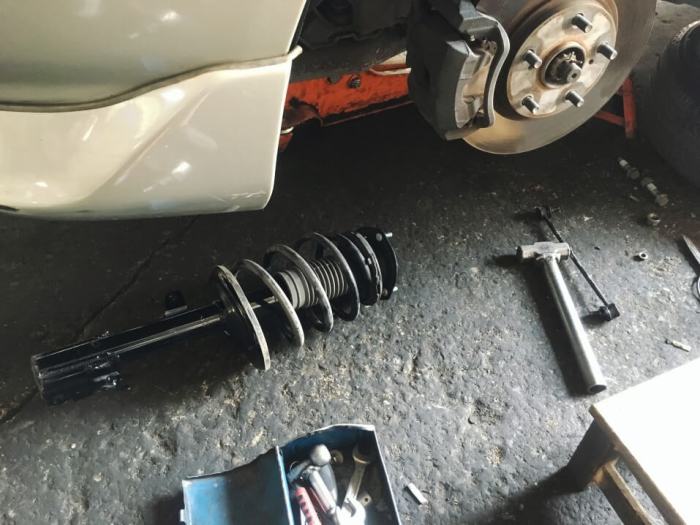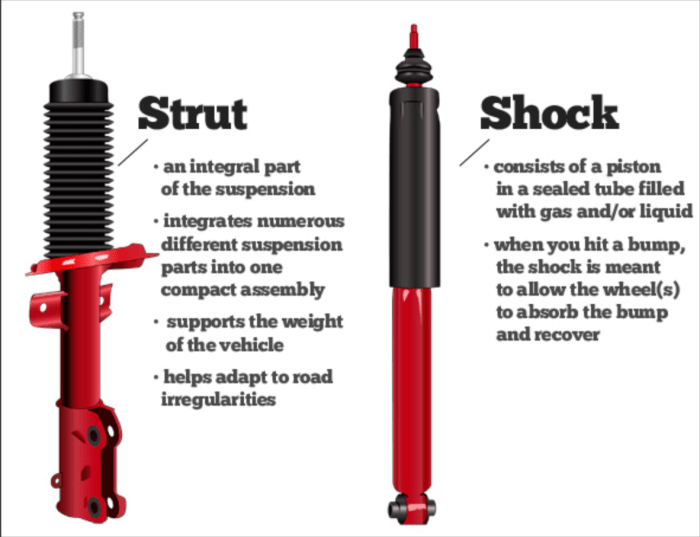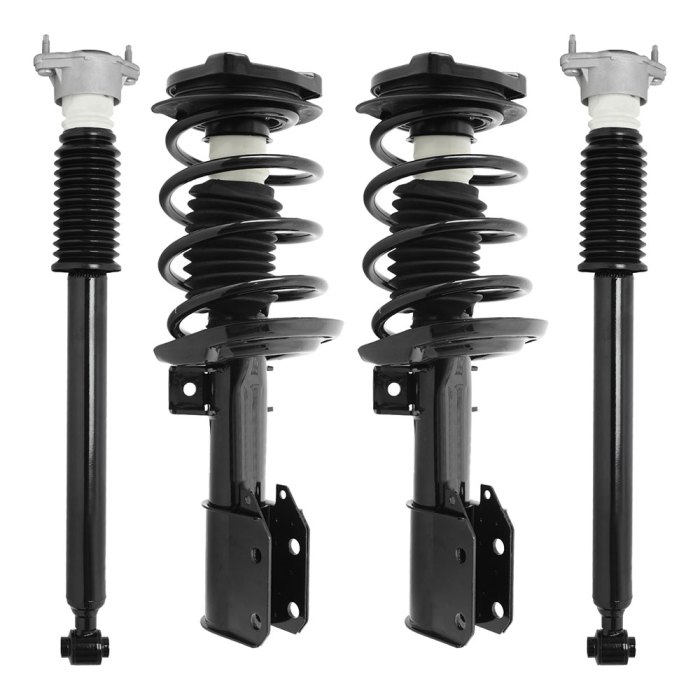Signs you need new struts and shocks? Dude, your car’s suspension is way more important than you think! Ignoring those little bumps and rattles could lead to some serious handling issues, not to mention a seriously uncomfortable ride. We’re talking about everything from sketchy cornering to scary braking – basically, your car could turn into a bouncy, unpredictable monster.
Let’s dive into the telltale signs that your struts and shocks are on their last leg.
This isn’t just about a smoother ride, it’s about safety. Worn-out suspension components can significantly impact your car’s ability to handle, brake, and even stay on the road, especially in less-than-ideal conditions. Knowing the signs of trouble can save you from a potentially dangerous situation and a hefty repair bill down the road. So, let’s get to it!
Visual Signs of Worn Struts and Shocks
Okay, so you’re thinking your car’s suspension might be on its last legs. Before you head to the mechanic, a quick visual inspection can save you some cash (and maybe some embarrassment if you’re wrong!). Let’s look at some telltale signs of worn struts and shocks. Remember, this is just a visual check; a proper diagnostic test is always best for certainty.
Leaking Struts and Shocks
Worn struts and shocks can leak fluid, which is a pretty clear sign of trouble. This fluid is typically a thick, oily substance, often dark brown or black from age and contamination. Leaks usually appear around the shaft where it enters the strut or shock body. You might see drips on the garage floor, or a noticeable accumulation of fluid around the component itself.
The more fluid you see, the more severe the leak, and the more likely it is that the component is failing.
Inspecting Strut Mounts for Wear and Tear
Strut mounts sit on top of the strut and connect it to the vehicle’s body. These rubber components are crucial for absorbing vibrations and providing a smooth ride. Cracks, tears, or significant wear on the rubber bushing of the strut mount are clear signs of deterioration. You’ll often see these issues as visual deformities or splits in the rubber itself.
So, your car’s bouncing like a basketball? That’s a major sign you need new struts and shocks. It’s all about that suspension system, you know? Think of the precision engineering involved – even in crazy custom jobs like 3D-printed custom parts for Ferraris , where every component needs to be perfect. Getting back to your ride, ignoring worn struts and shocks is a recipe for a seriously uncomfortable and unsafe drive.
A severely damaged mount will likely show significant cracking or even separation of the rubber from the metal components.
Visual Differences Between Healthy and Worn Shock Absorbers, Signs you need new struts and shocks
A healthy shock absorber will look relatively clean and unblemished. The shaft will move smoothly and will return to its original position quickly. A worn shock absorber will often show signs of wear and tear, such as leaking fluid (as discussed above), damage to the boot (the protective rubber covering), or a noticeably slower return to its original position when compressed.
The shaft might also show signs of corrosion or pitting.
| Feature | Healthy Shock | Worn Shock | Image Description |
|---|---|---|---|
| Shaft | Clean, smooth, no corrosion or pitting. Moves freely and returns quickly. | May be corroded, pitted, or scratched. May move sluggishly or not return to its original position quickly. | Imagine a shiny, chrome-like rod for the healthy one, while the worn one looks dull, with some brownish streaks and maybe some small dents. |
| Boot | Intact, no tears or cracks. | Torn, cracked, or missing. | Picture a perfectly smooth, rubbery sock, versus one with several rips and holes. |
| Fluid | No visible fluid leaks. | Visible fluid leaks around the shaft, often dark brown or black. | Think of a pristine, dry surface versus one with noticeable oil stains. |
| Overall Appearance | Clean, unblemished, and generally in good condition. | Shows signs of wear and tear, such as corrosion, damage to the boot, and fluid leaks. | A healthy shock would appear relatively new and untouched, while a worn one would look aged and damaged, with discoloration and possibly rust. |
Vehicle Handling Issues Indicating Worn Struts and Shocks
Worn struts and shocks significantly impact a vehicle’s handling, making it feel less responsive and potentially dangerous. The difference between driving a car with well-maintained suspension and one with worn components is substantial, affecting everything from cornering to braking. This section will detail the specific handling issues that arise from neglecting your vehicle’s suspension system.
Cornering Performance
With worn struts and shocks, a vehicle will feel less stable and more prone to body roll during cornering. Instead of a smooth, controlled turn, you’ll experience excessive swaying and a feeling of the car leaning heavily into the turn. This is because the worn components are unable to effectively control the suspension’s movement, allowing for excessive bounce and sway.
In contrast, a vehicle with new struts and shocks will corner with much more precision and stability, exhibiting minimal body roll and a feeling of confident control. The difference is akin to the difference between navigating a turn on a stable bicycle versus a wobbly one. The car with new components will feel planted and responsive, while the car with worn components will feel loose and unpredictable.
So, your ride’s been bouncing like a basketball lately? That’s a major sign you need new struts and shocks. But hey, while you’re upgrading your suspension, why not treat your whip to some serious eye candy? Check out these awesome Carbon fiber body kits for Mercedes-AMG , then get back to fixing those bouncy struts and shocks so your sweet ride handles like a dream.
Braking Performance
Worn struts and shocks negatively affect braking performance in two key ways: increased stopping distances and reduced vehicle stability. During braking, the weight of the vehicle shifts forward, and the suspension system needs to manage this weight transfer effectively to maintain stability. Worn struts and shocks cannot effectively control this weight shift, leading to increased nosedive and a longer stopping distance.
Additionally, the instability caused by worn components can make the vehicle more prone to skidding or losing traction during braking, especially on slippery surfaces. The result is a less predictable and potentially dangerous braking experience compared to a vehicle with new struts and shocks. Imagine the difference between braking on a smooth, level road versus braking on a road with potholes – the worn suspension is akin to the pothole scenario, making the stopping process less controlled and efficient.
Driving Over Bumps and Uneven Surfaces
Driving over bumps and uneven surfaces with worn struts and shocks is a jarring experience. The vehicle will bounce excessively, making for a rough and uncomfortable ride. You’ll feel every imperfection in the road, and the vehicle will likely continue to oscillate or “rebound” after hitting a bump, making it difficult to maintain control. In contrast, a vehicle with new struts and shocks will absorb bumps smoothly, providing a much more comfortable and controlled ride.
The difference is analogous to the experience of driving a car with well-inflated tires versus underinflated tires – the underinflated tires, like worn struts and shocks, will transmit every road imperfection directly to the occupants. The impact is significantly reduced with the new components, creating a more refined and pleasant driving experience.
Noise Indicators of Worn Struts and Shocks

Worn struts and shocks don’t just affect your car’s handling; they often announce their demise with a symphony of unsettling noises. These sounds can range from subtle squeaks to alarming clunks, and paying attention to them can help you catch a problem before it becomes a major (and expensive) repair. Identifying the type of noise and when it occurs can even help pinpoint which strut or shock is failing.Identifying the source of these noises requires a bit of automotive detective work.
The sound itself, its timing, and its location all provide valuable clues. Let’s break down some common noises and their causes.
Types of Noises Associated with Worn Struts and Shocks
Several distinct sounds indicate that your struts or shocks are nearing the end of their lifespan. These noises are often exacerbated by specific driving conditions.
- Knocking: A sharp, metallic knocking sound often occurs when driving over bumps or potholes. This usually means a worn-out strut mount or bushing is allowing the strut to hit against other components. It’s a pretty distinct sound, like something metallic is hitting something else metallic. The knock is often sharp and isolated rather than a continuous rumble.
- Clunking: A dull thudding or clunking noise is often associated with worn-out shock absorbers. This sound is usually more of a low-frequency thump and can occur during braking or acceleration, particularly when going over uneven surfaces. Think of it as a heavier, less precise sound than a knock. It’s less metallic and more like something heavy hitting something else heavy.
- Squeaking: A high-pitched squeal or squeak is often the result of worn bushings or rubber components within the strut assembly. These noises are usually more noticeable during turning maneuvers as the weight shifts and puts stress on the suspension components. It’s a very distinct sound; it’s high-pitched and easily identifiable as a squeal or squeak, almost like rubbing rubber.
Conditions Under Which Noises Occur
The conditions under which these noises occur can offer important clues about their source.
- Driving over bumps: Knocking and clunking sounds are often most pronounced when driving over bumps, potholes, or uneven surfaces. This is because these imperfections in the road force the suspension to work harder, exposing the wear and tear in the struts and shocks.
- Turning: Squeaking noises are often more noticeable during turns, particularly sharper turns, as this stresses the suspension components. The shifting weight puts pressure on the bushings and mounts, leading to the characteristic squeak.
- Braking: Clunking noises can sometimes be more noticeable during braking, especially if the shocks are severely worn. This is because the sudden deceleration puts added stress on the suspension system.
Locating the Source of the Noise
Pinpointing the location of the noise can help you determine which strut or shock is causing the problem. For example, if you hear a knocking sound coming from the front right of your vehicle, it’s likely that the front right strut or its associated components are worn. Similarly, a squeak from the rear left suggests a problem with the rear left strut or its components.
Paying close attention to where the noise originates can save time and money during the diagnosis and repair process. Try to listen carefully while someone else drives the vehicle over a bumpy road. The location of the noise will help a mechanic pinpoint the problem area.
Performance Issues Indicating Worn Struts and Shocks

Worn struts and shocks significantly impact a vehicle’s performance, leading to a noticeable degradation in handling, responsiveness, and overall driving experience. These components are crucial for maintaining stability and control, so their deterioration translates directly into a less safe and less enjoyable ride. The differences between driving a car with new and worn suspension components are substantial and readily apparent to even casual drivers.Steering Response and Vehicle Stability at Higher SpeedsWorn struts and shocks directly affect how a vehicle responds to steering inputs.
With new components, steering feels precise and responsive; the car turns smoothly and predictably. The driver feels a direct connection to the road, and corrections are easily made. However, with worn struts and shocks, the steering feels vague and imprecise. There’s a noticeable delay between turning the wheel and the car responding, and the vehicle may wander or drift.
This is especially problematic at higher speeds, where maintaining control becomes more challenging. The car may feel less stable, prone to swaying, and difficult to keep on its intended path. This lack of responsiveness and increased instability significantly reduces the driver’s ability to react to unexpected events, like sudden lane changes or avoiding obstacles. For example, imagine navigating a winding mountain road; a car with worn suspension will require far more effort to maintain control compared to a car with properly functioning struts and shocks.
The difference in stability is dramatically apparent, particularly at higher speeds where centrifugal forces are more significant.Uneven Tire WearWorn struts and shocks can cause uneven tire wear. The suspension system’s job is to keep the tires in consistent contact with the road. When the struts and shocks are worn, they fail to properly dampen the up-and-down motion of the wheels, causing excessive bouncing and uneven weight distribution.
This leads to certain parts of the tires contacting the road more than others.
Typical Tire Wear Patterns Due to Worn Struts and Shocks
Imagine a tire viewed from the side. We can describe the wear patterns as follows:If the struts are worn, the tires may show feathering, where the edges of the tire treads wear down more quickly than the center. This often presents as a cupped or scalloped pattern, with alternating high and low points along the circumference of the tire.
This is because the tire is not making even contact with the road surface. If the shocks are worn, you might see more of a one-sided wear pattern, where one side of the tire is worn down significantly more than the other. This is because the worn shocks allow excessive bouncing and tilting, causing the weight of the vehicle to shift unevenly onto the tire.
These uneven wear patterns are not only expensive to fix (requiring premature tire replacement) but also represent a significant safety hazard, as uneven tires can lead to unpredictable handling and reduced traction. A visual representation would show a tire with clearly defined areas of greater wear, illustrating the cupping or feathering effect on the tread. One side of the tire might show considerably more wear than the other, depending on whether the problem is primarily with the struts or shocks.
Testing and Diagnosis of Worn Struts and Shocks

So, you think your car’s suspension might be shot? Before you shell out cash for new struts and shocks, let’s talk about how to actually diagnose the problem. There are several ways to check for wear and tear, ranging from simple DIY tests to professional inspections. Knowing what to look for can save you time and money.
The Bounce Test
The bounce test is a quick and easy way to get a general idea of your shock absorbers’ condition. It assesses the damping ability of the shock, which is its capacity to control the spring’s rebound. A worn shock will allow excessive bouncing. To perform the test:
- Firmly push down on one corner of your vehicle (one at a time), corresponding to a single wheel and shock. You should feel some resistance.
- Release the corner and observe how many times the vehicle bounces before coming to rest. A healthy shock absorber will limit the bounce to one or two oscillations. More than that suggests damping issues.
- Repeat this process for each corner of the vehicle. Inconsistent bounce behavior between corners further points to a problem.
Interpreting the results is straightforward. One or two bounces? Probably okay. Three or more? It’s time to start considering replacement.
Keep in mind that this is a basic test; a more thorough evaluation is often necessary.
Visual Inspection of Shock Absorber Rebound
A visual inspection can supplement the bounce test, providing additional clues about the condition of your shocks. Focus on these key areas:
- Fluid Leaks: Check the shock absorber shafts and surrounding areas for any signs of oil or fluid leaks. This is a clear indication of internal damage and the need for replacement.
- Rust and Corrosion: Extensive rust or corrosion on the shock body can weaken the component and compromise its performance. While surface rust may not immediately indicate failure, severe corrosion is a red flag.
- Damaged Boots: The rubber boots protect the shock shaft. Tears or damage to these boots can allow contaminants to enter the shock, leading to premature wear.
- Bent or Damaged Shafts: Inspect the shock shafts for any bends or damage. This is often caused by impact or severe stress and is a sign of serious damage.
Remember, a visual inspection should be part of a broader assessment. It doesn’t replace other diagnostic methods.
Professional Mechanic Diagnosis
While DIY tests can provide a preliminary assessment, a professional mechanic offers a much more comprehensive diagnosis. They possess specialized tools and expertise to accurately identify worn struts and shocks. A mechanic might use several methods, including:
- Specialized Testing Equipment: Mechanics use equipment that measures shock absorber damping more precisely than the bounce test. This provides quantifiable data on shock performance.
- Visual Inspection: Mechanics conduct a thorough visual inspection, looking for signs of leaks, damage, and wear, often with the car on a lift for better access.
- Road Test: A road test allows the mechanic to assess the vehicle’s handling and identify issues not easily detected through static testing. They pay close attention to steering response, braking performance, and overall ride quality.
A mechanic can provide a definitive diagnosis and recommend the appropriate course of action, which may include repair or replacement of the struts and shocks.
End of Discussion: Signs You Need New Struts And Shocks
So, there you have it – a rundown of the key indicators that your struts and shocks are ready for retirement. From visual inspections to noticing changes in your car’s handling, the signs are pretty clear. Ignoring these issues could lead to bigger problems, so if you’re noticing any of these symptoms, it’s time to get your car checked out by a pro.
Remember, a safe and comfortable ride is worth the investment!









